Episodes
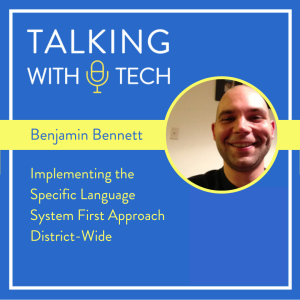
Wednesday Jun 08, 2022
Wednesday Jun 08, 2022
This week, Chris has an amazing interview with Benjamin Bennett, an AAC Specialist for the Escondido Union School District near San Diego, CA. Benjamin has a wealth of information to share, including his school’s move from doing traditional AAC evaluations to a model that is more focused on the considerations of the whole team. Benjamin has lots of questions about the strengths and drawbacks of the Specific Language System First Approach (SLSFA) - his district is strongly considering moving more towards the SLSFA and he wanted to think through possible issues before rolling it out. To learn more about about the SLSFA from Chris, click here.
Before the interview, Chris and Rachel have a great discussion about writing effective goals for AAC users, including tracking spontaneous language and independent initiation. According to Rachel, independent initiation has to be a foundational skill if we want everything else, because “we see a lot of kids who can do a lot with support, and not a lot without it.” She thinks that we need to be open to all the ways students are communicating with us - if they aren’t using the word we are working on but they are communicating, that is still growth and should be recognized.
Key ideas this week:
🔑 Students in school should not be required to respond - they aren’t getting paid to be there and it isn’t their choice. We shouldn’t put all of the communication responsibility on the student - instead, let’s ask, what can we do to make communication more tempting?
🔑 Benjamin shares about a school site that has a variety of students who are nonspeaking, minimally verbal, and verbal all using the same systems in the moderate/severe classrooms. This helps get everyone involved with AAC and no longer isolates the nonspeaking students. It just becomes “how we teach” instead of a tier 3 support that only a few students have access to.
🔑 One thing to consider if someone comes in with an AAC system that is different than what is typically used at a new school site - are they independently using the device to communicate? If the device is being used effectively, there is a very strong argument for keeping them on that system and not disrupting their motor plan by moving them to a different one.
🔑 People often think about putting everyone on the same tool, but what about strategies? Is there consistency of communication partners between sites? Do people focus on the same things and model the same way across the district? That is often a bigger concern than the particular system.
Visit talkingwithtech.org to access previous episodes, resources, and CEU credits that you can earn for listening to TWT episodes!
Help us develop new content and keep the podcast going strong! Support our podcast at patreon.com/talkingwithtech!

Wednesday Jun 01, 2022
Wednesday Jun 01, 2022
This week, we present Rachel’s interview with Laura Taylor, a Special Education Teacher and AAC Specialist with a years of experience teaching language and literacy to people with complex communication needs. Laura has done amazing work utilizing the Pragmatic Organization of Dynamic Displays (PODD), a form of AAC that, at least in the early stages, focuses on teaching communication functions along with vocabulary.
Before the interview, Rachel shares about a client of hers with Childhood Apraxia of Speech. This client was strongly averse to AAC - he would even protest against looking at an iPad with AAC on it. Rachel describes how she got him to start using AAC by giving him a “Please don’t take off my sweater” button! Rachel and Chris then discuss the value in teaching students to protest and to direct the actions of others.
Key ideas this week:
🔑 PODD is a low-tech or high-tech AAC solution that allows for direct access or partner-assisted scanning. PODD starts out organized by communication function and moves on to organization by category later. It also focuses more on suffixes/morphology as time goes on.
🔑 One advantage of PODD is its organization by pragmatic function. Having vocabulary organized this way may help demonstrate to the student what they can communicate about more frequently than other organization methods. Many students are used to the pragmatic functions of answering questions or requesting but not much else. Using PODD may give these students a head start with extra exposure to these other communication functions.
🔑 If you are trying to figure out how to get started with teaching literacy and communication, Laura recommends to “just start.” Do what you can manage. Start small and it can build to big things - modeling, communication opportunities, etc. Get strategic with yourself on one thing that will make an impact - then you can get good at that and build off that!
You can find out more about Laura and PODD at Tayloreducationalconsultants.com and can reach Laura via email at Tayloredconsultants@gmail.com
Visit talkingwithtech.org to access previous episodes, resources, and CEU credits that you can earn for listening to TWT episodes!
Help us develop new content and keep the podcast going strong! Support our podcast at patreon.com/talkingwithtech!
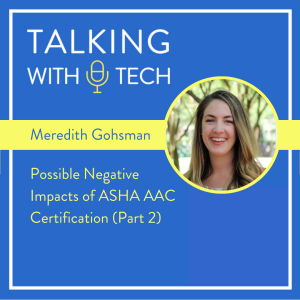
Wednesday May 25, 2022
Wednesday May 25, 2022
This week, we hear Part 2 of Dr. Meredith Gohsman's interview with Chris and Rachel! Meredith, Chris, and Rachel reflect on the meeting they attended at the last ASHA convention about ASHA AAC Certification. While previous meetings they attended were more concerned regarding ASHA AAC certification, at ASHA the crowd was more in favor of the certification. Meredith, Chris, and Rachel remain concerned about ASHA AAC certification and discuss some possible negative consequences, including possible impacts on device funding and reducing personal ownership of AAC for some communication partners.
Key ideas this week:
🔑 Parents should always be the most important “expert” on their child. The leader of the AAC team should be the caregiver or the AAC user themselves. AAC Certification may lead people to think that the AAC Specialist needs to be leading the AAC team in decision making.
🔑 An ASHA AAC Certification could potentially make communication partners feel more intimidated by AAC. It could be a reason that caregivers and communication partners to say “I don’t do AAC, I’m not an expert” We don’t need anything to take away from the idea that AAC is for all, and it’s everyone’s responsibility.
🔑 It is possible that insurance companies may make it harder for non-AAC Specialists to get funding for a device. Insurance companies might even require someone to be a certified AAC Specialist before they will fund a device.
🔑 One of the most important aspects of supporting AAC users is coaching their communication partners. It isn’t clear if the AAC Certification process will focus on coaching as much as it should; they may focus more on individual expertise in areas like AAC devices or 1:1 treatment.
Links:
stopaaccertification.org - website with resources and information about the effort to stop ASHA AAC certification. If you are interested in advocating for a stop or pause in the AAC Certification process, there are links on this site to templates and contacts where you can send your letter.
aacspecialist.org - home of the American Board of Augmentative and Alternative Communication; the website includes information in support of the potential ASHA AAC certification.
Committee on Specialty Certification: specialtycertification@asha.org
Feedback for ASHA Executive Board: https://www.asha.org/Form/Board-of-Directors-Feedback/
Visit talkingwithtech.org to access previous episodes, resources, and CEU credits that you can earn for listening to TWT episodes!
Help us develop new content and keep the podcast going strong! Support our podcast at patreon.com/talkingwithtech!
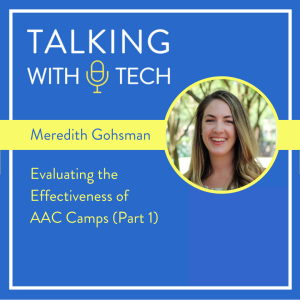
Thursday May 19, 2022
Thursday May 19, 2022
This week, Chris and Rachel interview Dr. Meredith Gohsman about her research into how much progress using their device AAC users made during a 4 week AAC camp. Each AAC user received aided language stimulation and was prompted using the least-to-most prompting hierarchy. Meredith’s results indicate that, after 9 sessions of AAC Camp, there was no change in the students receiving language instruction or the parents participating in sessions. The only change they saw was growth in therapy skills of the student clinicians who engaged in the interventions. Meredith says this may indicate that we need to be looking at a longer period than 4 weeks for making progress with AAC users. It may also suggest that we can make greater progress with graduate clinicians by giving them more hands-on experiences.
Before the interview, Chris and Rachel discuss Chris’s recent experience as a substitute teacher (due to staffing shortages in his district) in a co-taught general & special education class. Chris talks about some of the things he learned in that role, including the need for more flexible seating options and the general slow speed that public education can move - even when we know something is a better choice for the students. Chris also shares about how the students were all required to write in a composition book, and he wonders if there would be a way to honor other modalities for writing in a journal (e.g. Chromebook, speech to text, etc).
Key ideas this week:
🔑 When we are thinking about family-centered therapy, we should think about giving the families more hands-on training. In this study, the families didn’t get hands on opportunities, and they made little progress.
🔑 We have a responsibility to provide models and scaffolding for AAC users for a really long time. Some AAC stakeholders may approach modeling saying “A few weeks of modeling s is enough to see if they can use the device,” but in this case, nothing changed in 4 weeks.
🔑 Caregiver perceptions relate to both the child and the caregiver themselves - after training, the communication partner reports they feel more confident with using the device. When caregivers feel more confident, that will pave the way for better downstream outcomes for AAC users.
Visit talkingwithtech.org to access previous episodes, resources, and CEU credits that you can earn for listening to TWT episodes!
Help us develop new content and keep the podcast going strong! Support our podcast at patreon.com/talkingwithtech!

Thursday May 12, 2022
Thursday May 12, 2022
This week, we present Small Talks VI! “Small Talks” are short clips recorded with a previous guest that highlights one strategy or one idea in seven minutes or less. In this episode of Small Talks, we hear from Andy Smidt, India Ochs, Lory Chrane, Mark Nichols, and Tali Kellerstein!
Before the interviews, Chris and Rachel discuss Chris’s “design challenge” he helped create for some 5th graders to help figure out how to attach 3D printed AAC keyguards (i.e. overlays) to AAC devices without needing to remove the case (for warranty reasons). Chris talks about how this authentic problem got the students really excited, and he shares lots of great online resources for getting started with 3D printing keyguards (see links section below).
On this episode:
🗣️ Andy Smidt shares about universal design for learning, and how she is helping people see how UDL is something they already do in the classroom and there are benefits for educators as well as students in making the learning environment more universal.
🗣️ India Ochs talks about “tone policing”, a practice of criticizing the emotional manner in which a person has expressed a point of view, rather than addressing the substance of the point itself. Tone policing can occur when people are having a discussion about disability and ableism - by criticizing the person’s “tone”, they can avoid discussing any important changes.
🗣️Lory Chrane discusses Symbol-It, (https://symbolspeak.co/symbol-it/) a paid app that will translate verbal speech directly into symbols that correspond to the person’s AAC.
🗣️ Mark Nichols shares three of his favorite AT solutions right now, including enabling live captions for all videos, using “accessibility checkers” like Grackle (or ones embedded in Office) to make sure our files are as accessible, and converting the text files we assign to students into audio files for them.
🗣️Talk Kellerstein describes how she uses set up and clean up of games to introduce more opportunities to practice using speech or language. She also describes why she avoids games with batteries.
Links from this week’s episode:
Volksswitch.org - 3D printing resource for AT, including keyguards
Jennifer Schubring (@jjschubring on Twitter) has lots of great info about 3D printing keyguards here: https://www.buildingaac.com/post/3d-printing-keyguards-an-epic-journey
Tinkercad.com - create digital 3D printing designs
“No, We Won’t Calm Down: Tone Policing is Just Another Way to Protect Privilege”, an informative comic on Tone Policing shared by India Ochs
Visit talkingwithtech.org to access previous episodes, resources, and CEU credits that you can earn for listening to TWT episodes!
Help us develop new content and keep the podcast going strong! Support our podcast at patreon.com/talkingwithtech!
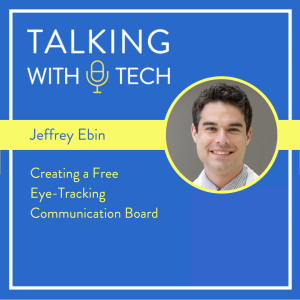
Wednesday May 04, 2022
Wednesday May 04, 2022
This week, Rachel interviews Dr. Jeffrey Ebin, an inventor and ER doctor at the University of Houston who created a FREE eye-tracking communication board (communicatonboard.io) that requires no more equipment than a camera (e.g. on a phone/tablet) and a web browser! Jeffrey shares all about his interest in creating Assistive Technology solutions, and how helping a man who was paralyzed from the neck down started him thinking about a free eye gaze website. One great thing about his communication board, particularly in the hospital setting, is the user can pick it up and learn it quickly without needing a lot of training for themselves or communication partners.
Before the interview, Chris and Rachel discuss a scenario that may be familiar to people who support AAC users - when we see someone with their AAC device in public, is it appropriate to go and talk to them (and/or their family) about it? Chris saw an AAC user at his daughter’s play and wanted to go and talk to them, but he hesitated and decided not to say anything. Rachel shares similar situations she has experienced, and the uncertainty that many SLPs feel when they are deciding whether to talk about communication outside of the clinical or school setting.
Key ideas this week:
🔑 Some of the vocabulary on the communication board is more specific to a hospital setting (e.g. suction), but there are plans for making the vocabulary customizable in the future.
🔑 The communication board (communicationboard.io) can be combined with an inexpensive receiver to operate things like light switches.
🔑 According to Dr. Ebin, a lot of the tech we are using in the field of assistive technology is outdated by 10-15 years, and in many cases much more expensive than similar technology in other fields. He believes we need to better incorporate the advances we are making in other areas of technology into assistive technlogy.
Visit talkingwithtech.org to access previous episodes, resources, and CEU credits that you can earn for listening to TWT episodes!
Help us develop new content and keep the podcast going strong! Support our podcast at patreon.com/talkingwithtech!
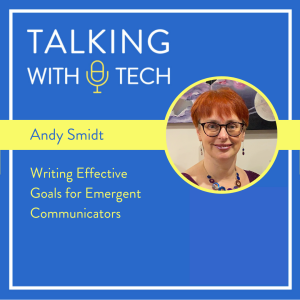
Wednesday Apr 27, 2022
Wednesday Apr 27, 2022
This week, we hear from Dr. Andy Smidt, a professor at the University of Sydney who teaches a number of courses related to communication and supporting people with severe intellectual disabilities. Andy shares about teaching pre-service professionals in unique ways, her “TEAM” taxonomy that can help write goals for emergent (presymbolic) communicators, and more!
Before the interview, Rachel and Chris talk about playing “The Mind”, a card game where you only use observation and nonverbal communication to sequence a set of cards together. They reflect on what they learned playing this game, including how essential nonverbal communication is to our everyday lives and how we can learn to observe very subtle signals. They also share about how we can observe nonverbal communication and then attach language to it in a therapeutic setting.
Key ideas this week:
🔑How do we support someone with severe intellectual disabilities who is presymbolic and may never become symbolic? We can presume their potential, but becoming a symbolic communicator may take a long time. How do we write goals to be worked on right now? Andy came up with the TEAM taxonomy for goal writing that is useful when working with pre-symbolic communicators:
T = Train, e.g. train communication partners
E = Expand, e.g. expanding what the AAC use already does. Expand the people they interact with, the activities they participate in, the situation in which the person uses potential communicative acts, expand the people who can interpret these communicative acts.
A= Augment, e.g. add something new. Allow the person to make choices in their daily routine. Add in new object symbols, community request cards, etc.
M= Move, e.g. for the person to move to become intentional or symbolic.
🔑In some cases, we need to regroup when we have hit a roadblock and look back at the TEAM framework. You might want to give it a few months and not add anything new - the AAC user may need a break to get comfortable with what they have already learned.
🔑Most clinicians feel they are doing family centered practice, but research indicates most families would say their therapy is not family centered. Family centered practice means going at the speed of the family, which may be slow if that is what they need.
Links from this Episode:
Full Text of Andy's article on the TEAM process
The Mind Card Game
Visit talkingwithtech.org to access previous episodes, resources, and CEU credits that you can earn for listening to TWT episodes!
Help us develop new content and keep the podcast going strong! Support our podcast at patreon.com/talkingwithtech!
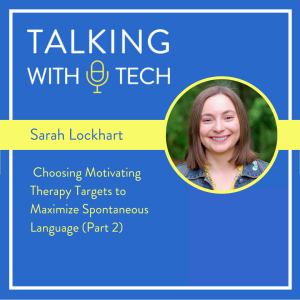
Wednesday Apr 20, 2022
Wednesday Apr 20, 2022
This week, we share Part 2 of Rachel’s interview with SLP and host of the SLP Happy Hour podcast, Sarah Lockhart! They continue their discussion of Sarah’s clients, including a nonverbal client who uses lots of scripts to communicate. Rachel shares ideas for how to choose targets for therapy, why we should be modeling language that is important to the AAC user, and how motivating materials during AAC assessment can help get a better picture of his or her true ability.
Before the interview, Chris and Rachel finish answering the question from last week about a student with a complex medical history that includes cortical visual impairment (CVI). Chris and Rachel discuss ideas for using books and TV shows the student loves to make therapy more fun, including watching YouTube and eliciting language from the video. They also talk about what to look at when the student isn’t making progress, including whether or not the activity they are doing is fun.
Key ideas this week:
🔑 When modeling, are you showing them language they might want to use? For example, it may be better to model “I don’t want to wake up” for a teenager than “Good Morning Mom”. Both are important, but, in this case, a modeled protest may be used spontaneously more readily than a greeting.
🔑 The most valid assessment is one in which the AAC user is motivated to engage - if we are assessing but forcing the student to label something uninteresting, they may not demonstrate their true skills.
🔑 How can we figure out where to start teaching language? One idea is to look at how AAC users are communicating nonverbally. If a child is already demonstrating non-verbal communication, it is an easy transition to giving them language to use instead of that gesture or action.
🔑 What are other ideas for choosing targets? Ask the communication partners - what does the student do all the time when no one is around? It can give us insight into what they are motivated by, such as sensory seeking behavior or refusal, which can then give you insight into targets and activities.
Links from this week’s episode:
Talking with Tech Episodes related to CVI: https://www.talkingwithtech.org/search?q=CVI
For resources related to coding, go to Code.org
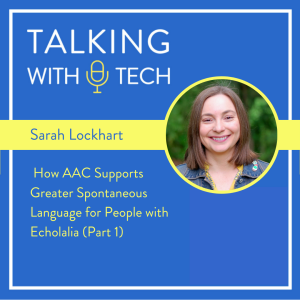
Thursday Apr 14, 2022
Thursday Apr 14, 2022
This week, Rachel interviews Sarah Lockhart, an SLP and host of the SLP Happy Hour podcast. Sarah had questions about providing AAC to a student who has limited spontaneous communication but used lots of scripts. Rachel and Sarah discuss the importance of supporting independent communication for echolalic students, how AAC benefits these students by providing visual word choices with auditory feedback, and more!
Before the interview, Chris and Rachel discuss a listener question about a student with a complex medical history, including CVI, who uses an eye gaze system. Rachel and Chris touch on how they would approach the case and some specific things that come to mind, including the challenges of directly prompting an eye gaze user, ideas for using games to teach language, and how they could use Canva in therapy to make something useful for the student’s school.
Key ideas this week:
🔑 If a student relies on us to open a folder on their device, how can it generalize to independence? It’s especially tempting to help an eye tracking user, but If we aren’t training from a motor plan approach, it may not generalize. If we start with supports, we need to fade them as soon as possible so they get the full motor plan.
🔑 It doesn’t move the needle for spontaneous autonomous speech to verbally say what we think they want to say and have them repeat that over and over again. In many cases this hasn’t worked for years.
🔑 You can support independent communication with AAC in ways you can’t with verbal speech alone, such as gesturing at the device with an expectant gaze
Visit talkingwithtech.org to access previous episodes, resources, and CEU credits that you can earn for listening to TWT episodes!
Help us develop new content and keep the podcast going strong! Support our podcast at patreon.com/talkingwithtech!
Links from this weeks episode:
Episode 147: Kaylie Gustafson: Supporting Eye Gaze Users Through Telepractice https://www.talkingwithtech.org/episodes/kaylie-gustafson?rq=Eye
Pepi's Wonder World: https://www.pepiplay.com/wonderworld/
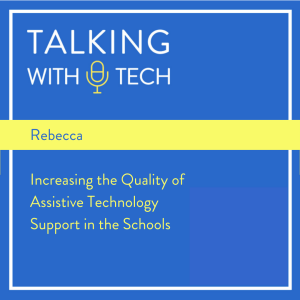
Wednesday Apr 06, 2022
Wednesday Apr 06, 2022
This week, Chris interviews Rebecca, a guest who requested to keep her last name anonymous. Rebecca is an assistive technology professional who supports a K-12 school district and was interested in putting together some information for her school board asking to increase the number of assistive technology specialists in her district. She and Chris break down some arguments for increasing the quality of AT in the schools, as well as topics like providing direct service minutes vs. coaching, how to calculate the impact you are having on the entire student body (not just students with IEPs), working together with staff development professionals for trainings, and more!
Before the interview, Rachel and Chris have a lively discussion about a hypothetical classroom with one AAC user who has some sensory seeking behaviors. Rachel and Chris go through their thoughts about the case, including how to approach the teacher, how to support language while also keeping the kids and the staff safe, and providing alternative sensory experiences for the student that may help avoid some of the sensory seeking behaviors.
Key ideas this week:
🔑 One argument for increasing the number of AT/AAC Specialists - there is a lot of time spent selecting the tool, but not much follow through on how to implement that tool. if you need better AAC implementation across the district, you may need to have a dedicated person for coaching.
🔑 Another argument for increasing the number of AAC Specialists - look at the numbers over the previous few years regarding the number of AT and AAC requests you are getting. In many districts, the numbers are growing rapidly.
🔑 There is a huge overlap between accommodations and assistive technology on an IEP - it may make sense to approach the IEP by writing “accommodations reflect AT considerations” under AT considerations, then exploring AT with the team as part of the accommodations discussion.
Help us develop new content and keep the podcast going strong! Support our podcast at patreon.com/talkingwithtech!
Visit talkingwithtech.org to access previous episodes, resources, and CEU credits that you can earn for listening to TWT episodes!

Join AAC experts Rachel Madel and Chris Bugaj as they dive into a weekly discussion about all things AAC (Augmentative and Alternative Communication). Every episode they deliver practical resources, clinical guidelines and relevant research to help clinicians better utilize technology for individuals with complex communication needs.
Episodes include interviews with industry thought-leaders, clinicians, parents, researchers and app developers to keep you on the pulse of the educational technology scene and better support communication through the use of technology.


